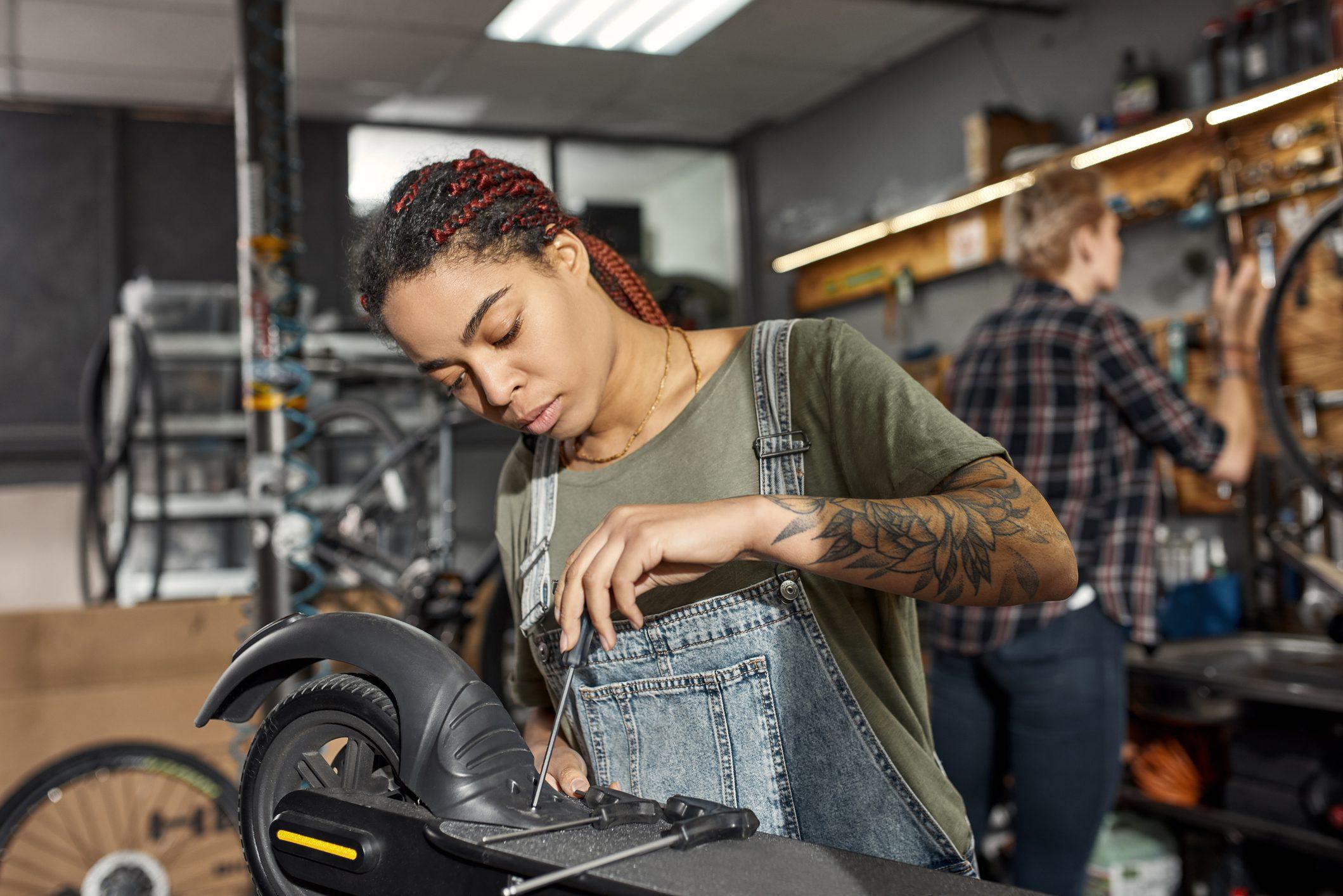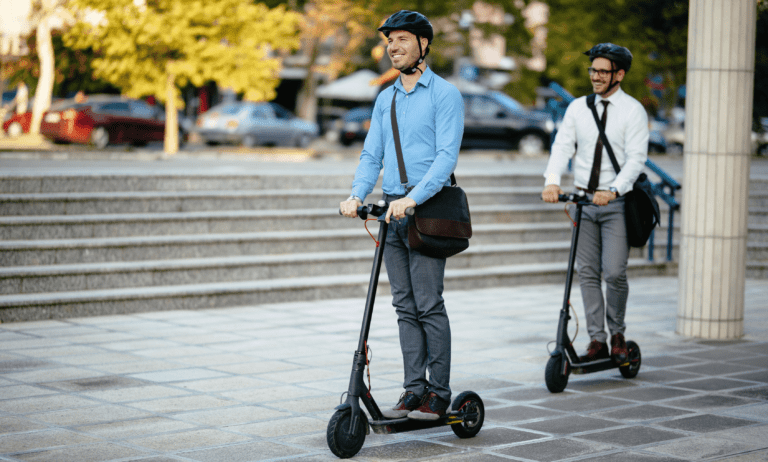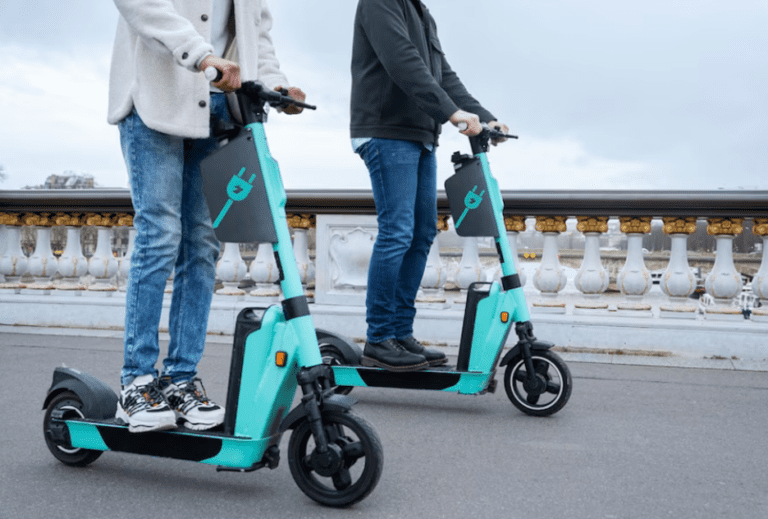Essential Electric Scooter Maintenance Tips
Electric scooters have revolutionized urban transportation, providing a convenient and eco-friendly way to navigate cities. To keep your e-scooter running smoothly and safely, regular maintenance is essential. This comprehensive guide will cover everything you need to know to maintain your electric scooter, from essential tools and cleaning tips to battery care and troubleshooting common issues.
Key Takeaways
Essential tools and regular maintenance are essential for electric scooter performance, safety, and lifespan.
Tire care including pressure checks, inspection for damage or wear, and timely replacement is important.
Regular brake maintenance as well as battery health practices can maximize the performance of your e-scooter while lubrication protects moving parts from wearing out quickly.
Table of Contents
Essential Tools for E-Scooter Maintenance

Always start with your owner’s manual to find out if your particular e scooter needs maintenance that is specific to it. Then, it’s important to gather the right tools for the job. Some essential tools include:
Cleaner (this non-toxic one works great on every part of a board)
Paper towels or shop rags
Tire pressure gauge (old school or digital)
These basic tools will help you perform regular maintenance tasks, such as tightening loose screws and adjusting brakes. For more complex tasks, such as extracting the inner tube of an electric scooter’s front wheel or dealing with a rear wheel issue, plastic bicycle levers will be a great help.
While many maintenance tasks can be done by e-scooter owners, those with high-value scooters should closely follow the instructions of their electric scooter maintenance guide and seek professional help for more complex issues.
Regular Cleaning: Keep Your Scooter in Top Shape

Regular cleaning is a pivotal part of electric scooter maintenance. Keeping your scooter clean not only improves its appearance, but also helps prevent rust, maintains functionality, and prolongs the life of vital components.
Before you take the hose to your scooter, make sure you know its IP rating. Most common scooters are rated between IPX4 and IPX6 ( 1-4= very little or no resistance to water or debris, 4=small splashes, 5=puddles, 6=big puddles and rain). Don’t risk damaging your scooter by hosing it down instead of taking a few extra minutes to clean it by hand with a rag. For an in depth explanation of IP ratings, see our article, Can You Ride an Electric Unicycle in the Rain?
The first step in electric scooter upkeep is to clean the scooter using a damp cloth and a general-purpose cleaning product (I personally love Simple Green for this, it’s not toxic or nasty smelling and it takes road grime off like a champ every time). This will help remove dirt and grime from the battery, wheels, tires, and other components.
In addition to regular cleaning, it’s recommended to deep clean your electric scooter once a month if you use it pretty much daily. This involves using specialist bike chain lube for certain parts, such as the chain. It’s also important to inspect your electric scooter once every one or two weeks, checking bolts, screws, and testing the brakes before each ride.
Tire Care: Pressure, Inspection, and Replacement

Appropriate tire care is important in electric scooter maintenance. Ensuring optimal tire pressure, inspecting for damage and wear, and replacing tires when necessary are all essential tasks to maintain your scooter’s performance and safety.
Let’s look at maintenance tips for both pneumatic air tires and solid tires.
Pneumatic Air Tires (air filled)
Pneumatic air tires, commonly found on electric scooters, require regular maintenance to ensure a smooth and safe ride. Maintaining the appropriate tire pressure is crucial, with the recommended pressure for electric scooters being between 40 and 50 psi. It’s advisable to check the tire pressure every few rides to prevent under or over inflation, which can lead to decreased performance and potential safety issues.
In addition to checking pressure, it’s important to inspect pneumatic air tires for any punctures or damage, particularly deep gouges or cuts in the outside rubber cover. Regularly examining your tires can help you identify and address potential issues before they become more significant problems.
Solid Tires
Solid tires have become increasingly popular on electric scooters due to their puncture-resistant nature. However, they also require regular maintenance to ensure optimal performance and safety. One of the most important aspects of solid tire maintenance is monitoring for wear.
As solid tires wear down, their performance and safety can be compromised, making it essential to replace them in a timely manner.
To properly maintain solid tires, it’s recommended to periodically inspect them for any signs of damage. Consistently monitoring your solid tires’ condition and replacing them when necessary will provide a safe and smooth ride on your electric scooter.
Brake Maintenance: Keeping Your Rides Safe

Brakes are one of the most critical components of your electric scooter, ensuring safe and controlled rides. Proper brake maintenance involves checking for wear, adjusting when needed, and replacing worn-out brake pads.
To assess the condition of your brakes, apply pressure to the brake while the scooter is stationary and attempt to push it forward. This simple test can help you determine if your brakes require adjustment or replacement.
Several types of brakes are available for electric scooters, including electric brakes, disc brakes, and band brakes. No matter which brake system your scooter employs, frequent inspection and replacement of brake pads when the friction material is almost depleted is necessary.
Fasteners and Cables: Keeping Your Scooter Secure

Fasteners and cables play a crucial role in keeping your electric scooter secure and safe to ride. Regularly inspecting and tightening these components can help prevent issues such as wobbly parts, loose connections, and even accidents. To maintain your scooter’s fasteners and cables, it’s important to check them periodically and tighten any loose connections.
It may be necessary to apply some Locktite to a fastener that keeps coming loose. This will help secure it in place. Maintaining vigilance on your scooter’s fasteners and cables and promptly addressing any issues will guarantee a secure and enjoyable riding experience.
Battery Health: Maximizing Performance and Lifespan

The battery is the heart of your electric scooter, powering your rides and determining the scooter’s overall performance and lifespan. Proper battery care involves using the correct battery charger, avoiding overcharging and extreme temperatures, and maintaining a healthy charge level. Following these electric scooter battery maintenance tips will enhance your scooter’s battery’s performance and lifespan.
Lithium-ion batteries, commonly used in electric scooters, have an expected lifespan of approximately 2-3 years or 350-550 full charge cycles. To prolong the life of your battery pack, it’s recommended to keep your scooter on a frequent charge cycle and to keep the charge between 30% and 80% of capacity.
Lithium ion batteries don’t like to be completely drained or absolutely full, keep the charge level in this sweet spot and yours will serve you well for many, many rides.
Lubrication: Protecting Moving Parts

Lubrication is essential for protecting and prolonging the life of your electric scooter’s moving parts. Applying a suitable lubricant, such as WD-40 Bike Chain Lube, (or a similar product that contains PTFE) to these components can help reduce friction, prevent rust, and extend the lifespan of various parts. It’s important to lubricate not only the chain but also joints between the wheel and the frame, as well as any other moving parts.
You also need to lubricate the folding mechanism and shock absorber. Generally, it’s best to use a small amount on components and wipe away any excess so the fluid doesn’t get into parts that it could damage.
To properly maintain your scooter’s moving parts, it’s recommended to lubricate them at least once a week depending on how much you use your scooter.
Troubleshooting Common Electric Scooter Issues

Despite regular maintenance, you may still encounter issues with your electric scooter. Troubleshooting common electric scooter issues involves checking the battery charge, inspecting wiring, fuses, and circuit breakers, and seeking professional help when necessary. Addressing these potential problems can help prevent more significant issues and ensure your scooter runs smoothly.
If you’re experiencing issues with your electric scooter, start by verifying the battery charge and inspecting the wiring for any frayed wires. If you’re still unable to diagnose the problem, it may be necessary to seek professional help.
Remember, regular electric scooter maintenance can help prevent many common issues, extend the life of your scooter and keep you safe while rifing.
Upgrading and Customizing Your Electric Scooter
Upgrading and customizing your electric scooter can not only improve its performance, comfort, and aesthetics, but also allow you to tailor your scooter to better suit your needs and preferences. Some popular upgrades and customizations include:
Helmet and safety gear
Lights (front and rear)
Lock
Phone holder
Handlebar accessories
Upgrading the battery
Upgrading the scooter wheels
Modifying the firmware or removing the speed controller
Before making any modifications to your electric scooter, make sure to consult your scooter’s manual or a professional to confirm the changes are safe and won’t damage it.
By upgrading and customizing you can design your own high quality electric scooter, that is a truly unique ride tailored to your personal preferences and needs.
BONUS TIP: Many bicycle and baby scooter accessories will work on an electric scooter as the handle and push bars are similar and most accessories adjust to fit different bar sizes.
Storing Your Electric Scooter: Best Practices

Proper storage of your electric scooter is essential for preventing damage and prolonging its lifespan. The recommended storage conditions for an electric scooter include a dry place away from direct sunlight and an environment with a stable temperature. Optimal locations for storing an electric scooter include closed dry storage rooms, such as a pantry, garage, or attic with adequate insulation and low humidity.
Before storing your electric scooter, ensure it’s fully charged and has been allowed to run until it cuts off due to a depleted battery.
Adhering to these best practices to maintain your electric scooter will safeguard it from damage and guarantee a longer-lasting, more reliable ride.
(The custom e scooter stand pictured is available from PartOfWood on Etsy.)
Summary
In conclusion, proper electric scooter maintenance is essential for ensuring a safe, efficient, and enjoyable riding experience. By following the tips and guidelines outlined in this comprehensive guide, you’ll be well-equipped to perform essential maintenance tasks, troubleshoot common issues, and even upgrade and customize your scooter. Remember, a well-maintained electric scooter not only performs better but also lasts longer, so invest the time and effort into keeping your scooter in top shape.
Frequently Asked Questions
Does electric scooter require maintenance?
Regular maintenance for electric scooters is essential to keep the electrical components functioning and reduce the probability of major problems.
Cleaning your scooter regularly and taking small steps can make a significant difference in the long term.
How do I take care of my electric scooter?
To take care of your electric scooter, make sure to clean it regularly, lubricate the moving parts, maintain the tires, check the brakes, inspect cables and fasteners, and care for the battery.
Regular cleaning and lubrication will help keep your scooter running smoothly and efficiently. Make sure to check the tires for wear and tear, and replace them if necessary. Inspect the brakes for any signs of wear or damage, and replace them if necessary. Check the cables and fasteners for any signs of damage.
How do you lubricate an electric scooter?
To lubricate an electric scooter, use a silicone lubricant on the wheel bearings, shock absorber, folding mechanism, and other parts of the scooter that may have gone creaky over time.
Make sure to use a lubricant that contains PTFE and avoid spraying any of it on brake pads or rotor surfaces if your scooter has disc brakes, or electric components.
How often should I clean my electric scooter?
It is recommended to deep clean your electric scooter once a month and inspect it regularly.



